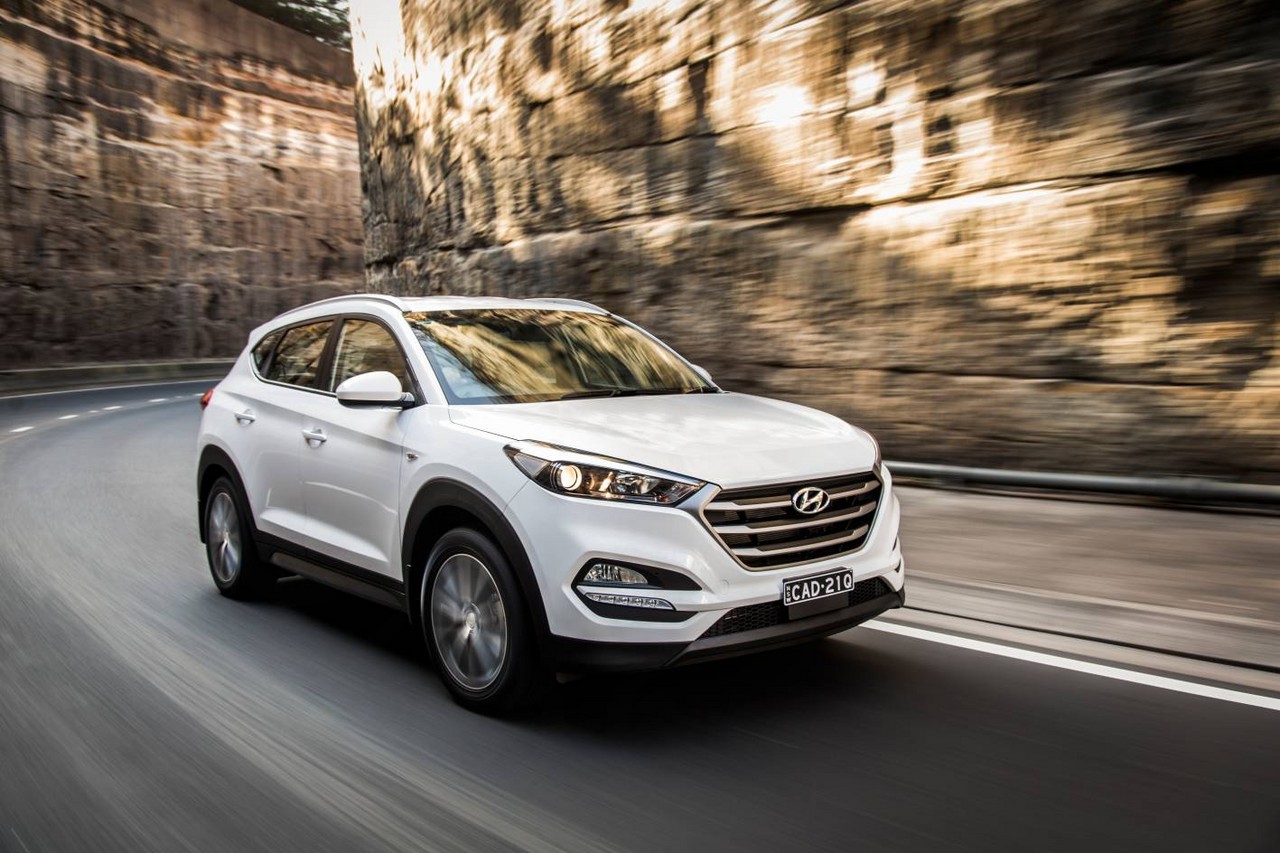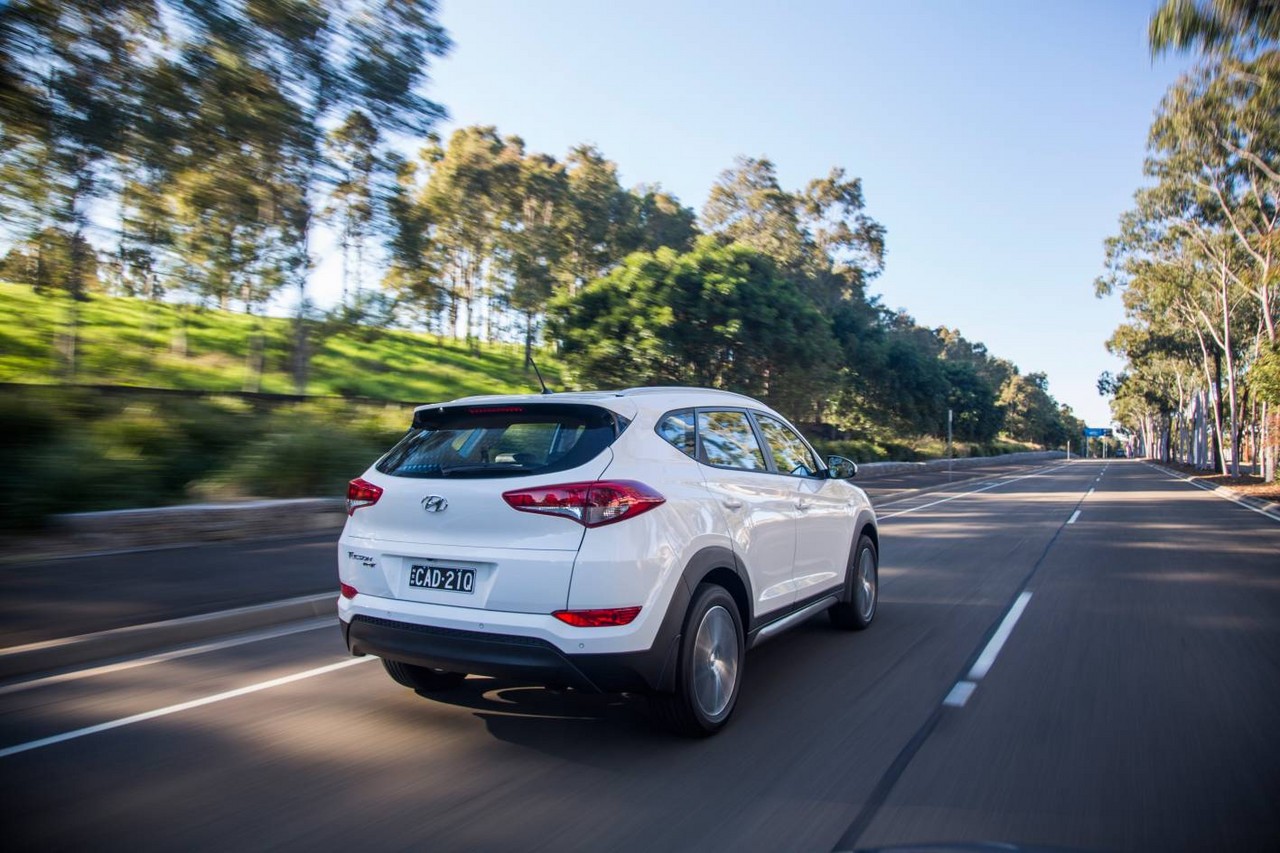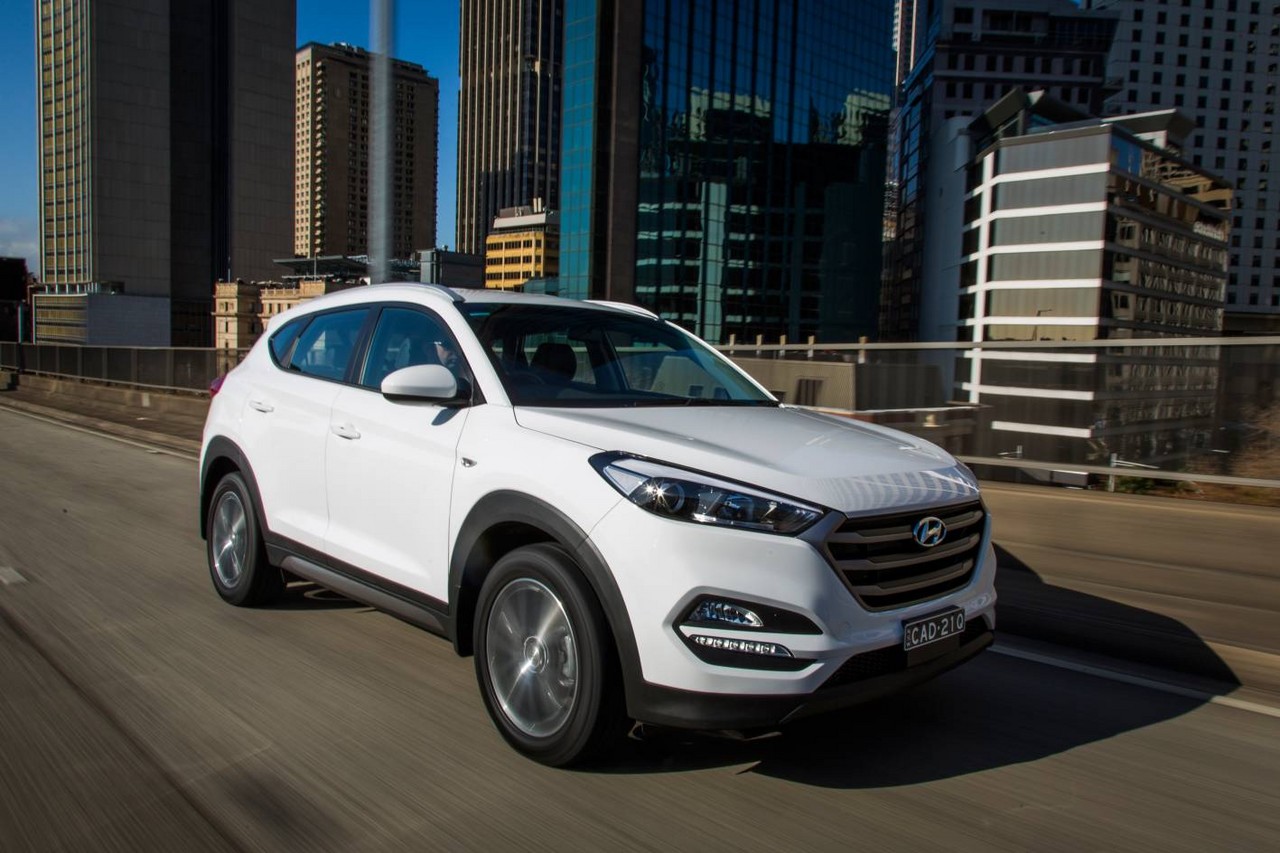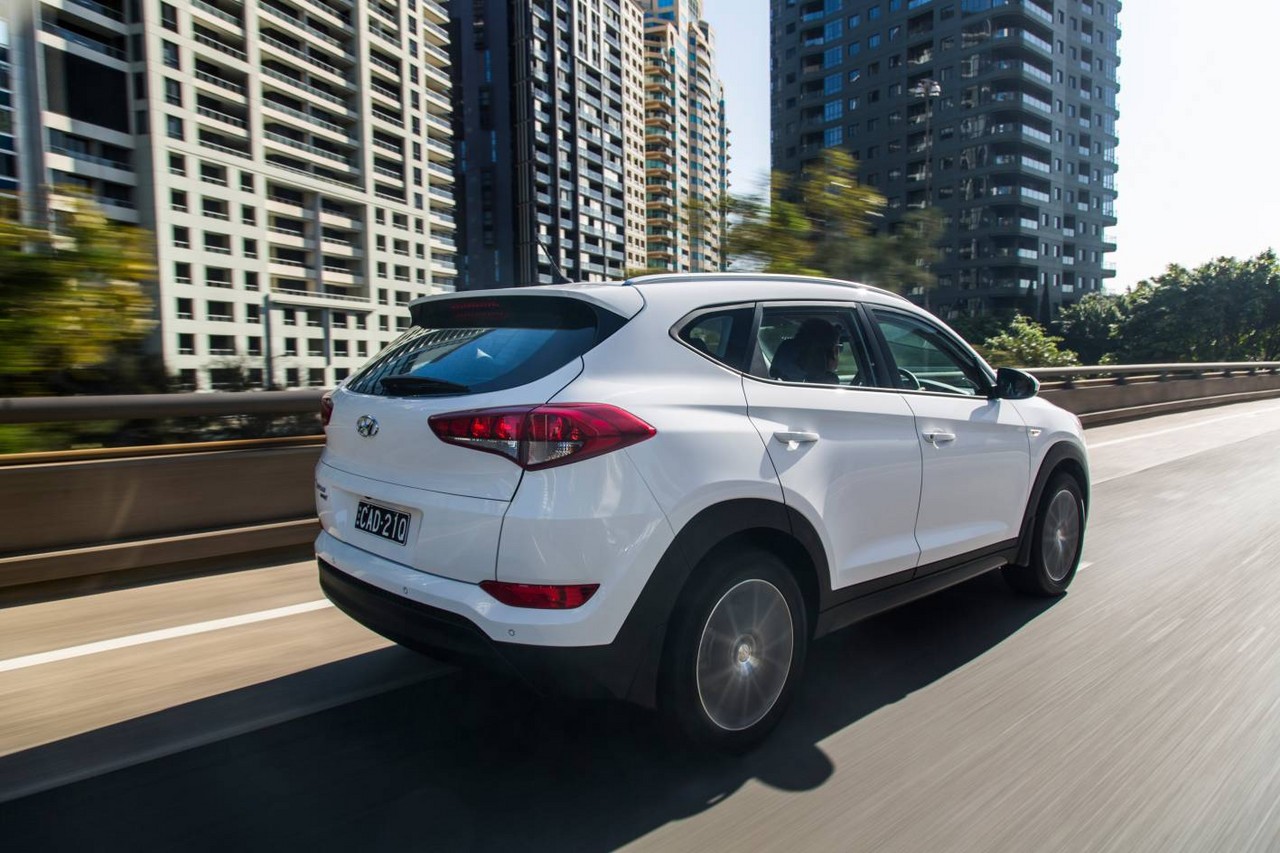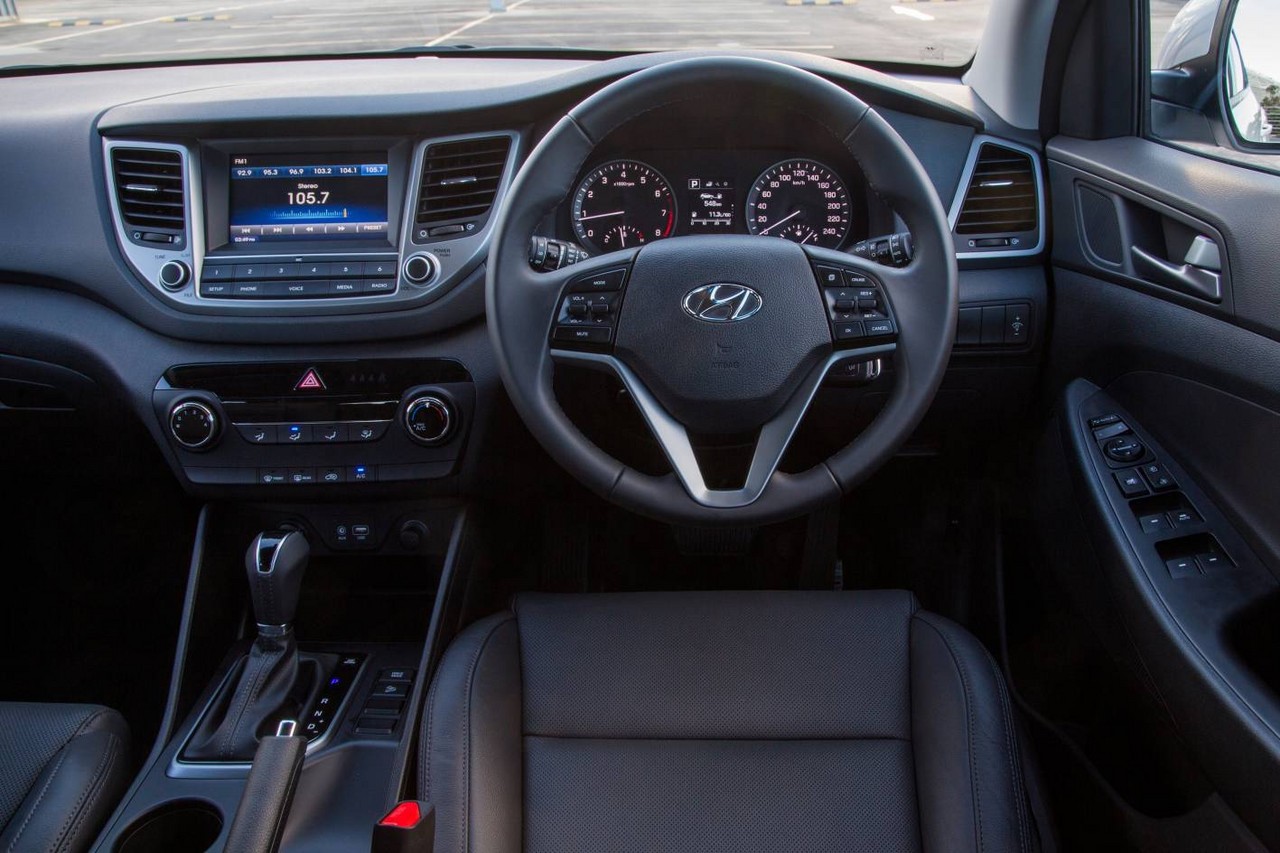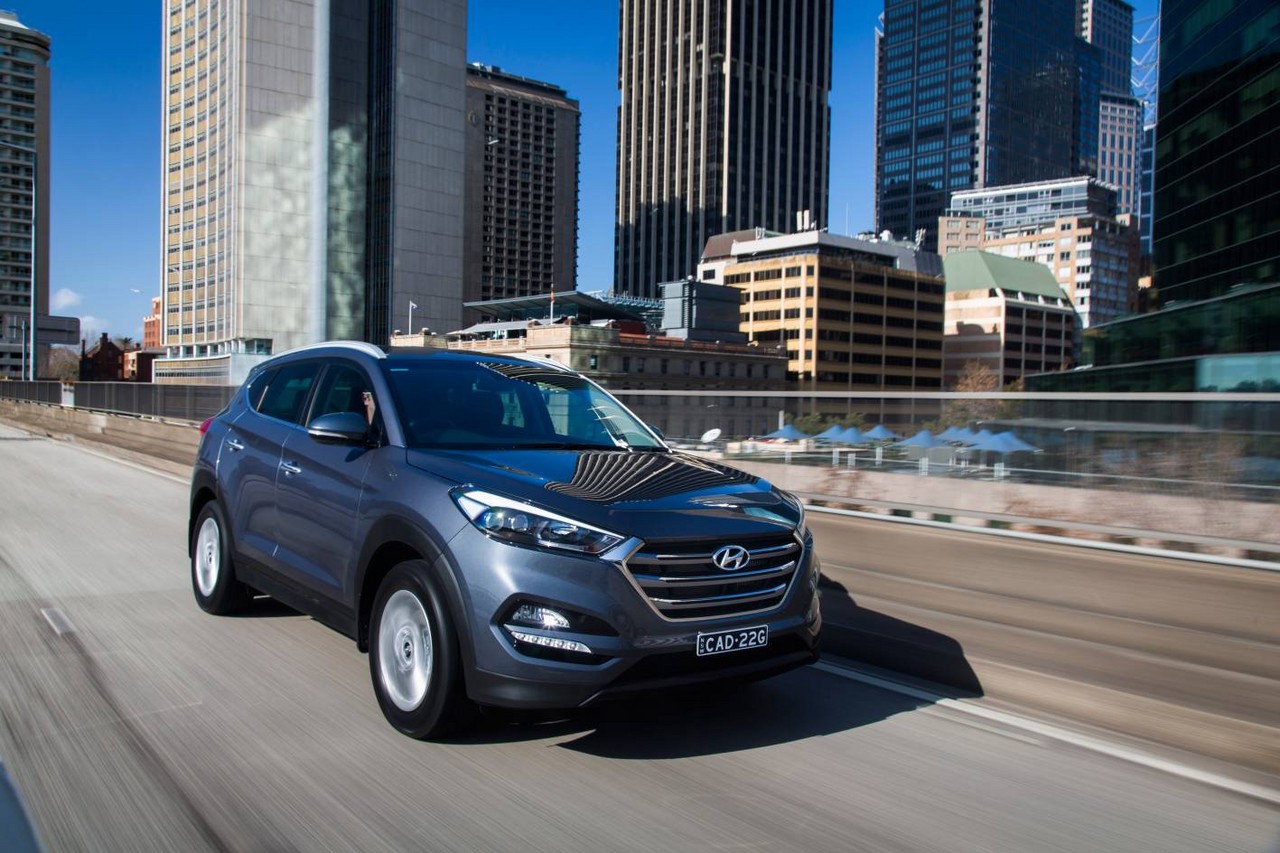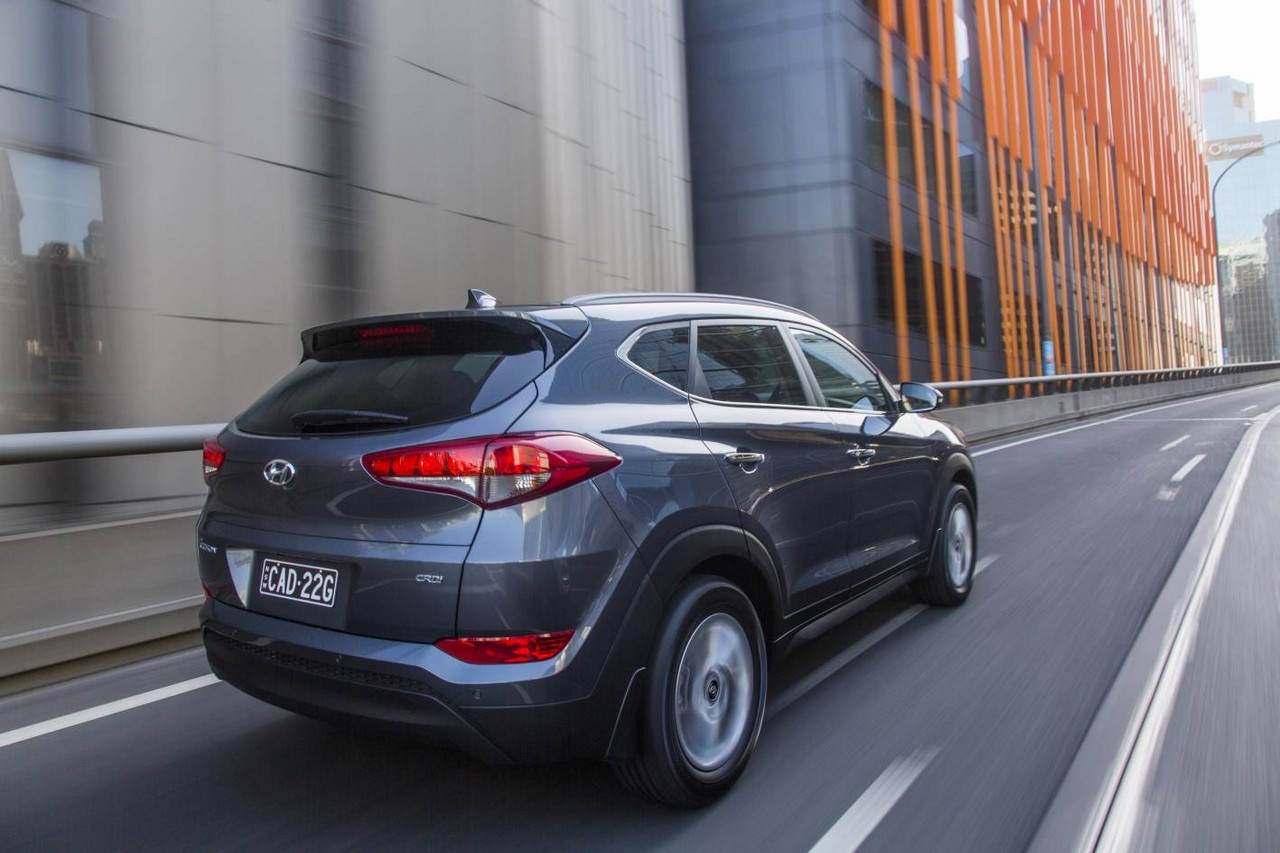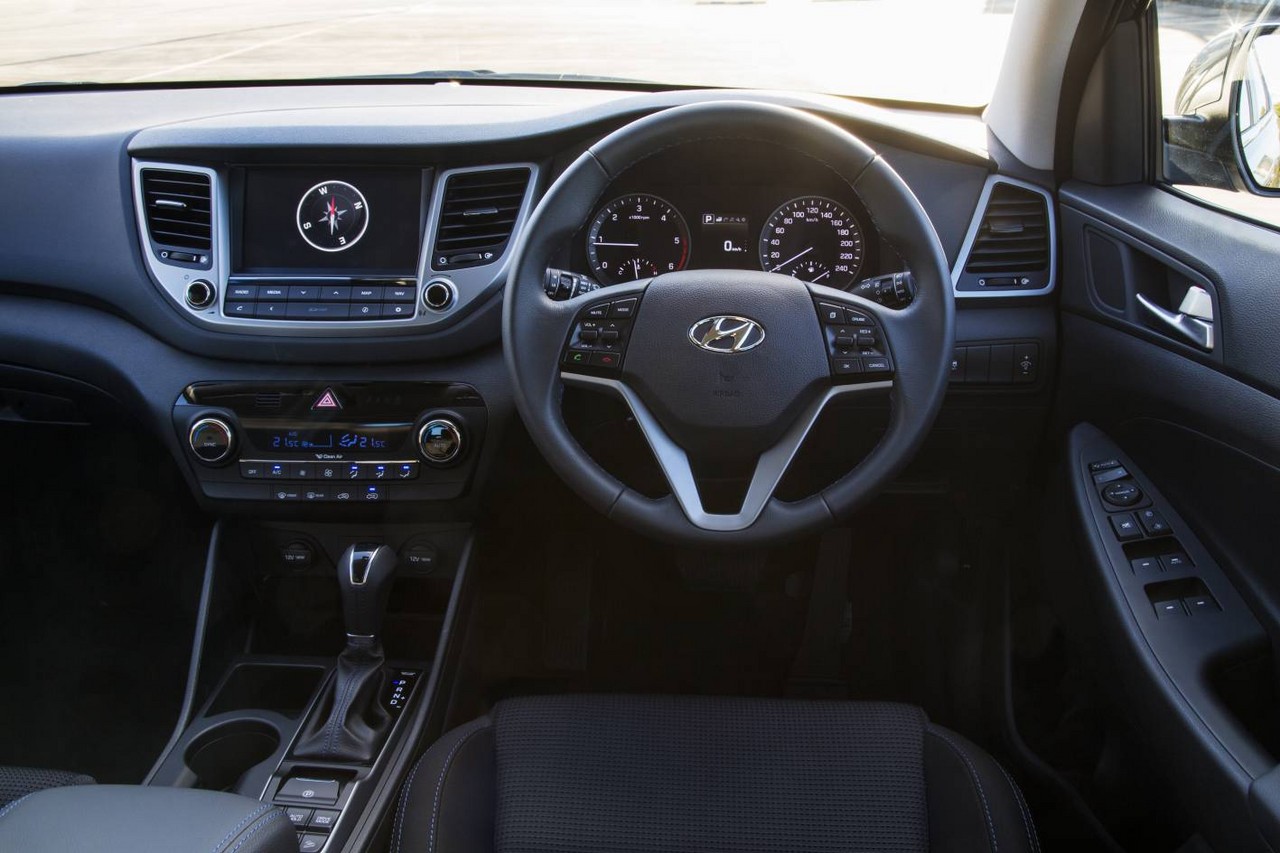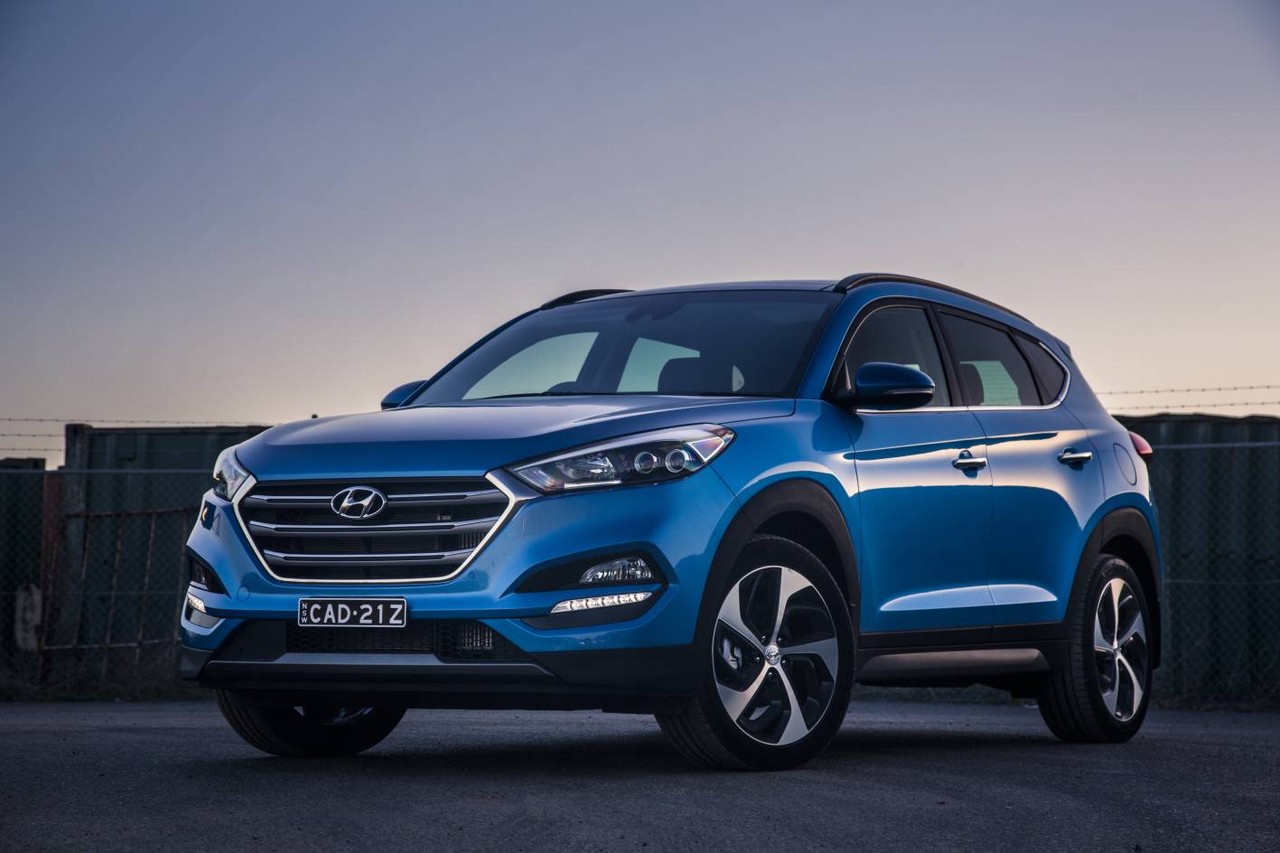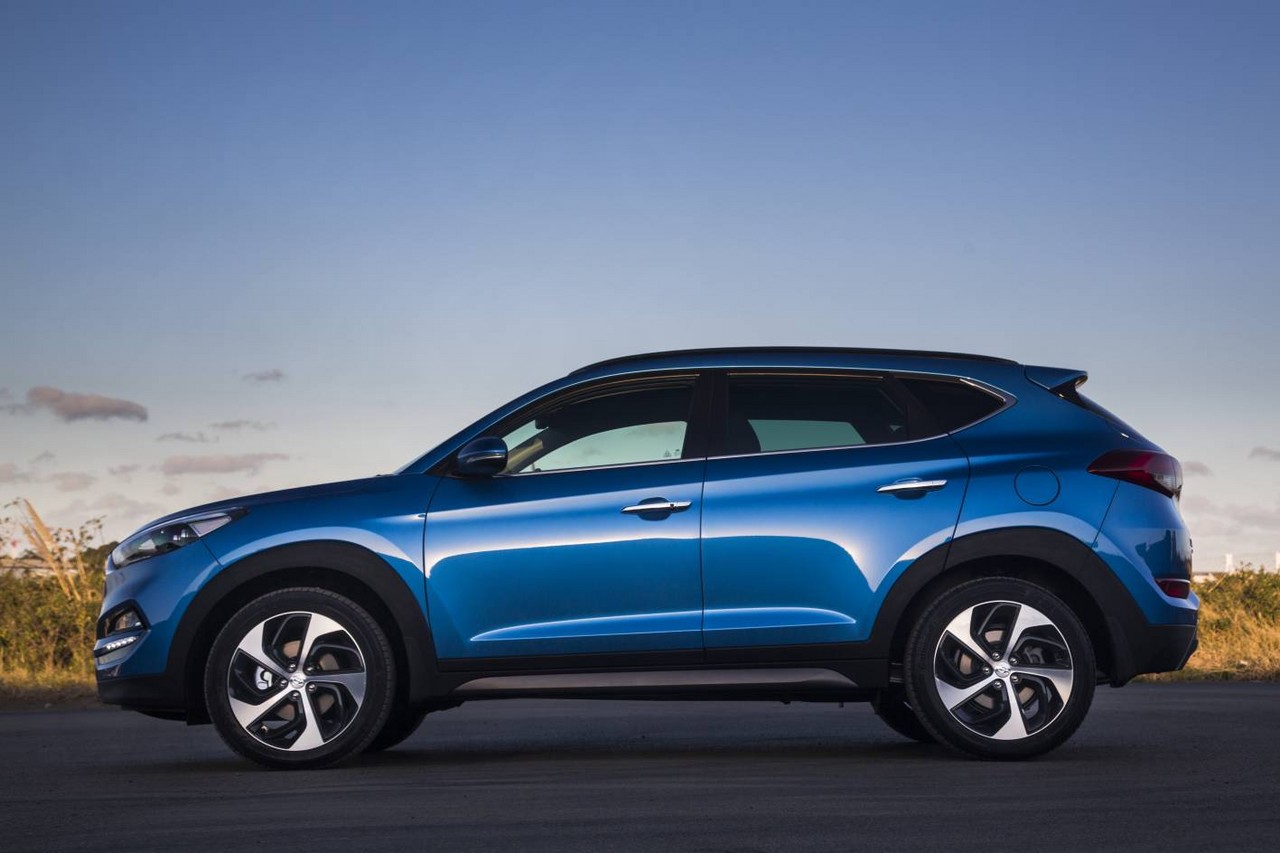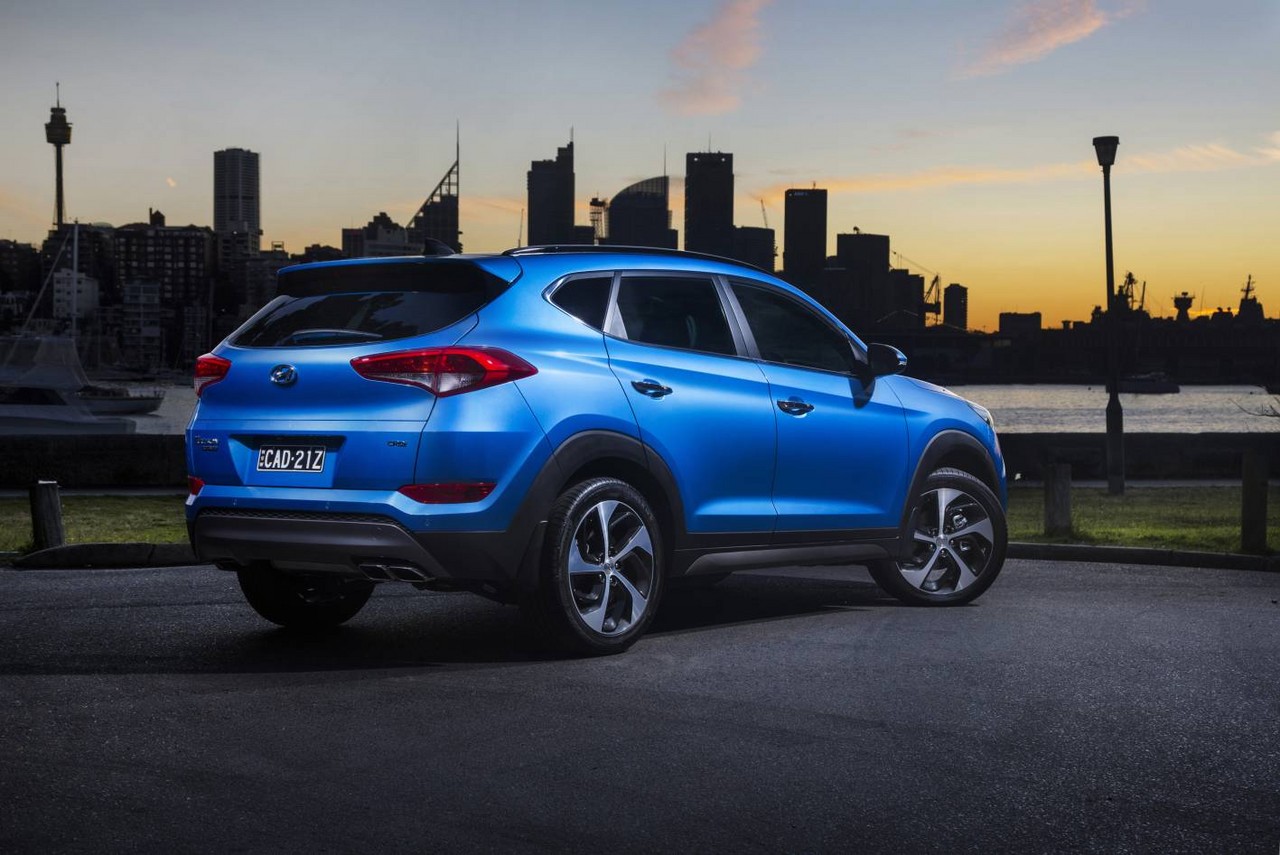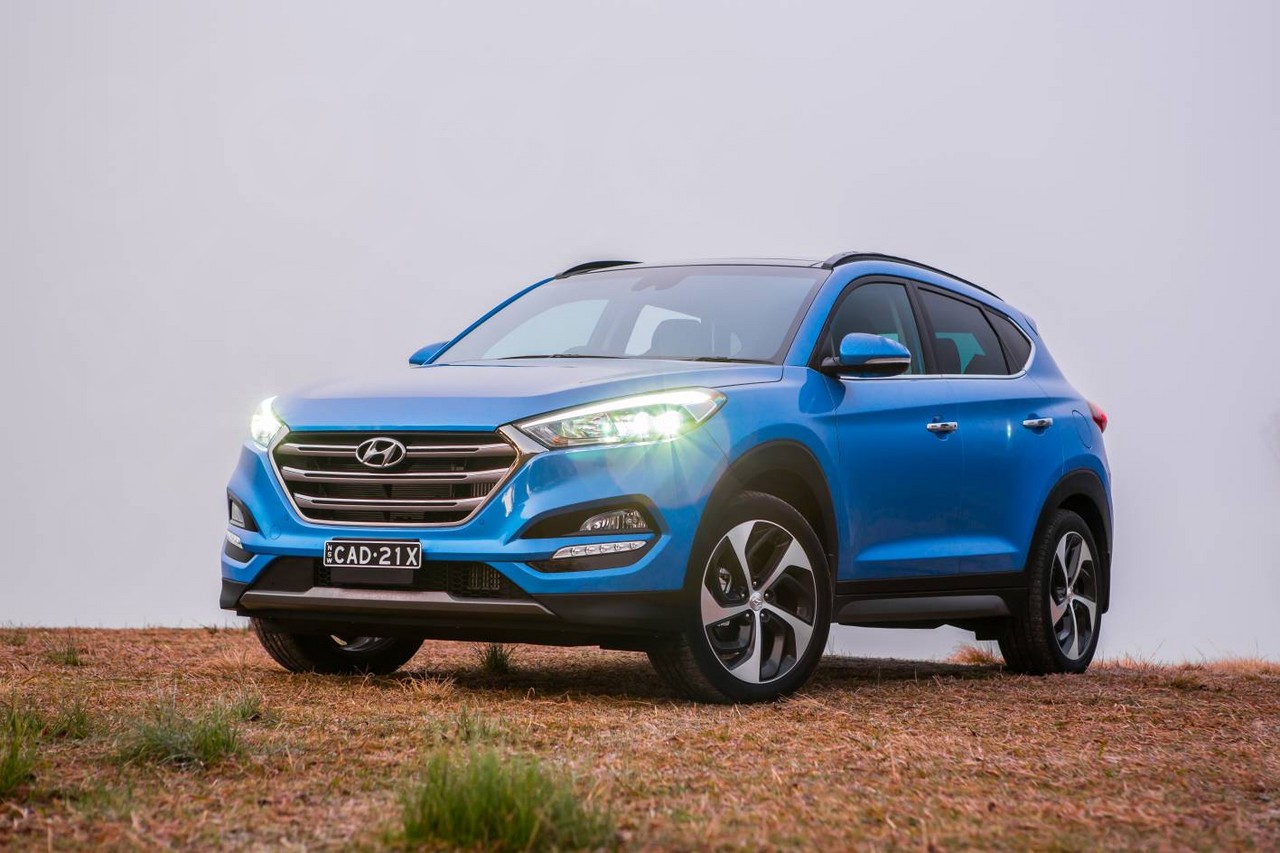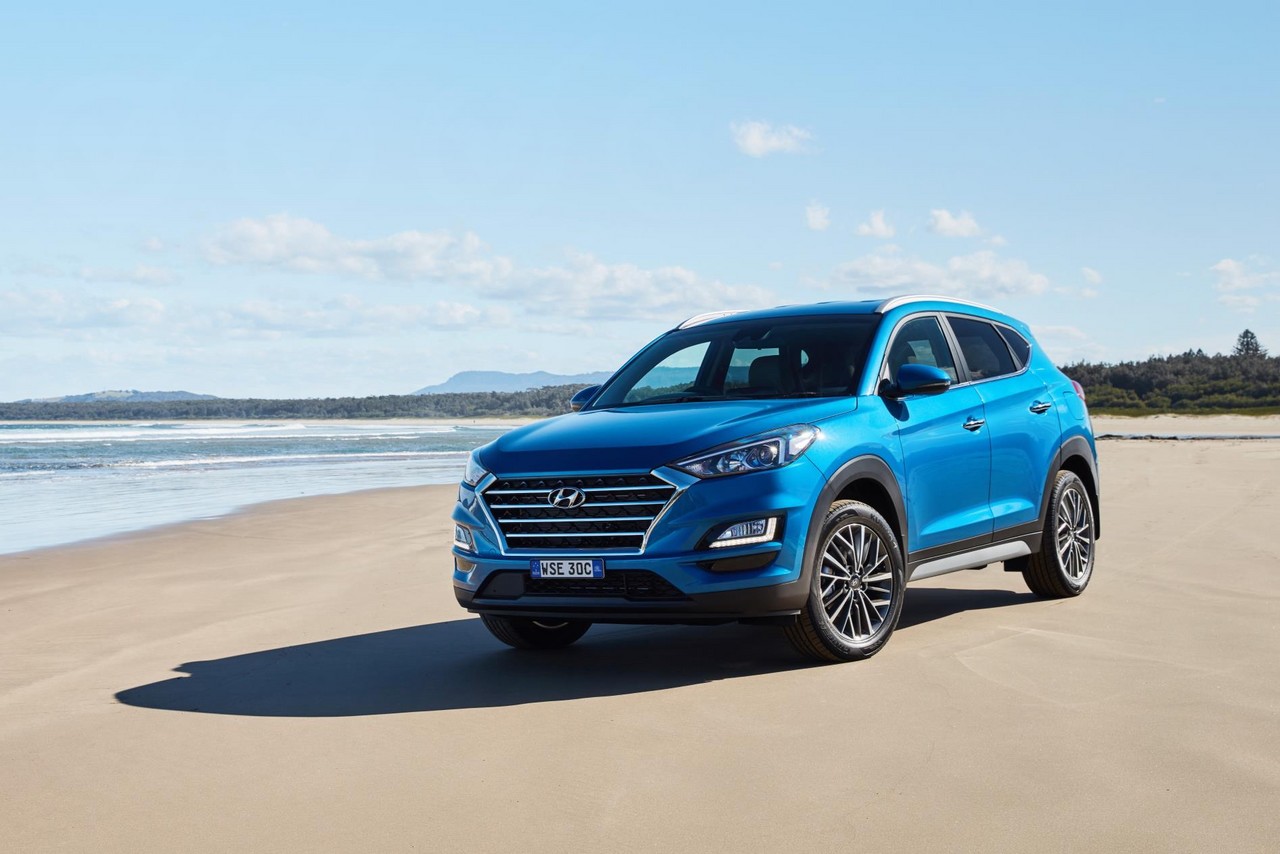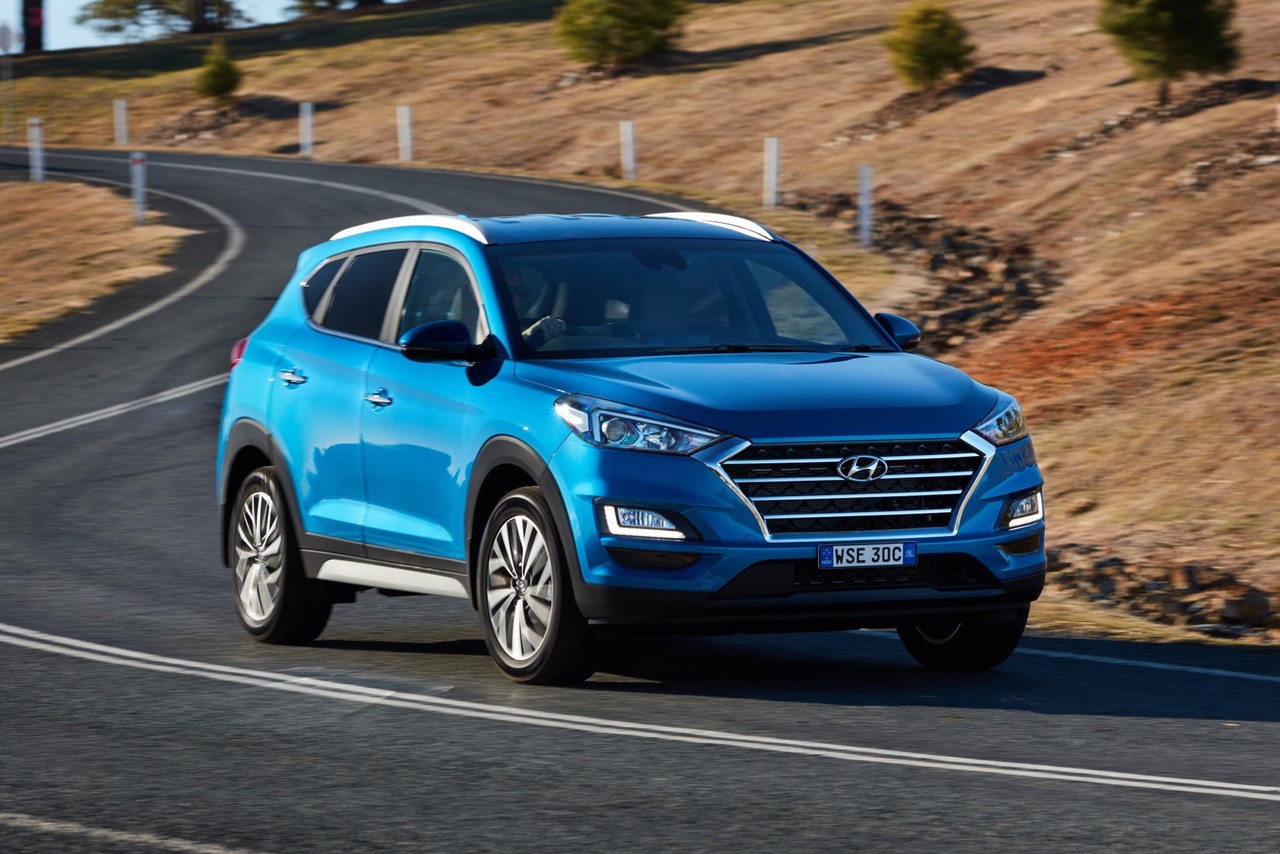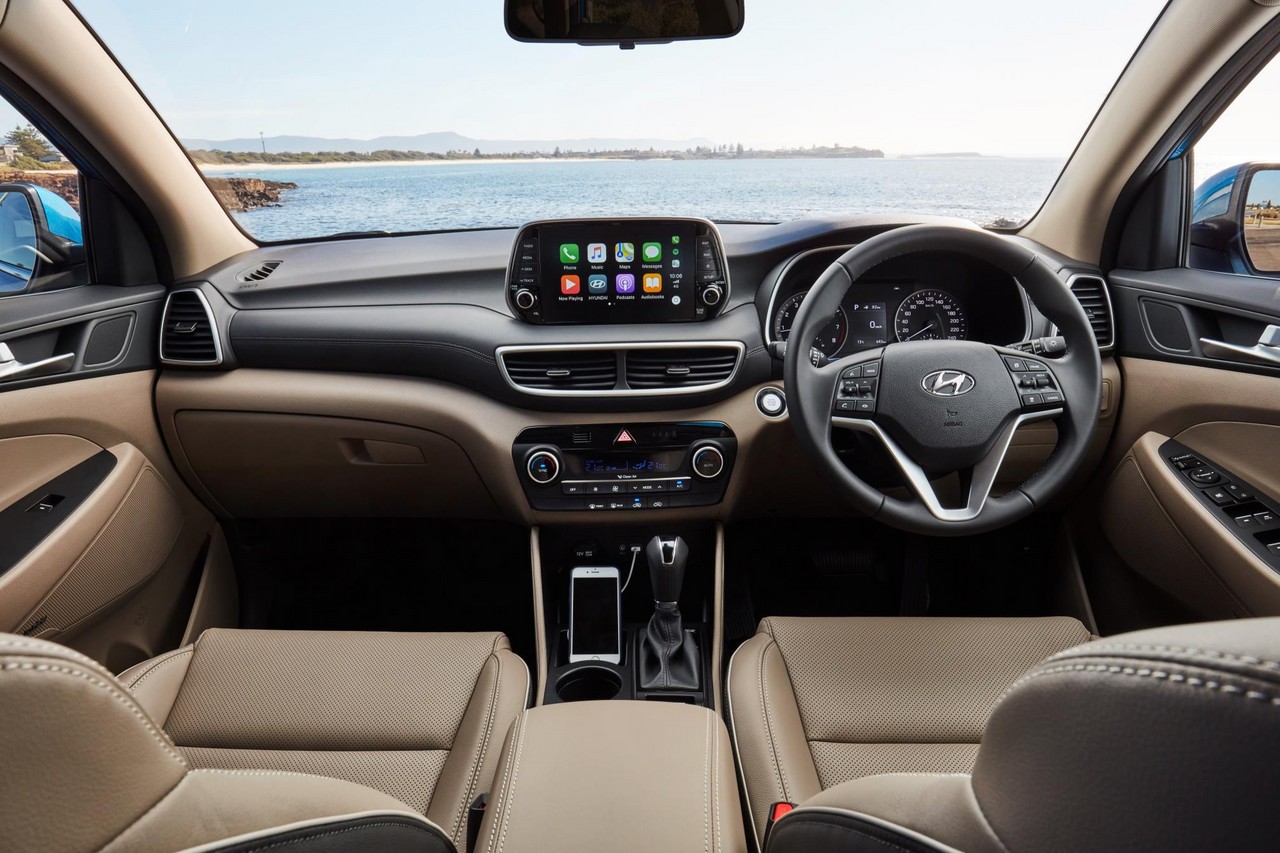
- Willing 1.6-litre turbocharged petrol engine
- Frugal 2.0-litre turbo-diesel engine
- Accomplished ride/handling balance
- Well-weighted steering
- Spacious and practical interior
- Four star ANCAP safety rating for pre-November 2015 vehicles
- Underwhelming 2.0-litre naturally aspirated petrol engines
- Long-travel brake pedal
- Road noise
- Some cheap and easily scratched interior plastics
Review: Hyundai TL.I Tucson (2015-18)
Overview
Officially released in Australia in July 2015, the Hyundai TL Tucson was a mid-size SUV. For Australia, the front- and all-wheel drive Hyundai TL Tucson was available with 2.0-litre petrol, 1.6-litre turbocharged petrol and 2.0-litre turbo-diesel engines. The Tucson range initially consisted of ActiveX, Elite and Highlander editions, with entry-level Active editions following later in 2015. Of these editions, the Tucson ActiveX was manufactured in Ulsan, South Korea, though the Active, Elite and Highlander editions were manufactured in Nosovice, Czech Republic.
Engines: Nu, Gamma and R (Diesel)
Of the engines,
- The Tucson 2.0 MPI was powered by the 2.0-litre G4NA petrol engine which was a member of Hyundai’s ‘Nu’ engine family and had an aluminium block and cylinder head, double overhead camshafts, four valves per cylinder, variable intake and exhaust cam timing (Hyundai’s ‘Dual Continuously Variable Valve Timing’ or D-CVVT), a two-stage variable induction system, multi-point injection and a compression ratio of 10.3:1;
- For the Tucson 2.0 GDI, the 2.0-litre G4NC ‘Nu’ petrol engine had similar properties but featured direct fuel injection and had a compression ratio of 11.5:1;
- The Tucson 1.6 Turbo GDI was powered by Hyundai’s G4FJ ‘Gamma’ turbocharged petrol. While the Gamma engine had similar properties to the G4NC ‘Nu’ engine, it was fitted with a twin-scroll turbocharger, an air-guided intercooler and had a compression ratio of 10.0:1; and,
- For the Tucson 2.0 CRDI, the 2.0-litre D4HA ‘R’ diesel engine has an aluminium block and cylinder head, common-rail direct injection with piezo-electric injectors (operating at 1800 bar), a variable geometry turbocharger, double overhead camshafts (chain-driven), four valves per cylinder, exhaust gas recirculation, a diesel particular filter and a compression ratio of 16.0:1.
April 2017 update
In April 2017, the Hyundai TL Tucson range was revised –
- The 2.0 MPI variant was discontinued;
- The 2.0 GDI engine was offered for Tucson Active and Elite editions (these models were manufactured in Ulsan, South Korea);
- Apple CarPlay and Google Android smartphone integration was standard for Elite and Highlander editions (previously limited to the Active and Active X editions).
| Engine | Edition | Trans. | Years | Peak power | Peak torque | |
|---|---|---|---|---|---|---|
| 2.0 MPI | 2.0-litre G4NA petrol I4 | Active | 6sp man., 6sp auto |
2015-17 | 114 kW at 6200 rpm | 192 Nm at 4000 rpm |
| Elite | 6sp auto | 2015-17 | ||||
| 2.0 GDI | 2.0-litre G4NC petrol I4 | ActiveX | 6sp man., 6sp auto |
2015-18 | 121 kW at 6200 rpm | 203 Nm at 4700 rpm |
| Active | 6sp man., 6sp auto |
2017-18 | ||||
| Elite | 6sp auto | 2017-18 | ||||
| 1.6 Turbo GDI AWD |
1.6-litre G4FJ turbo petrol I4 | Elite, Highlander |
7sp DCT | 2015-18 | 130 kW at 5500 rpm | 265 Nm at 1500-4500 rpm |
| 2.0 CRDI AWD |
2.0-litre D4HA turbo-diesel I4 | Active, Elite, Highlander |
6sp auto | 2015-18 | 136 kW at 4000 rpm | 400 Nm at 1750-2750 rpm |
AWD system
The Hyundai TL Tucson was available with a part-time all-wheel drive system which utilises a viscous coupling (i.e. no centre differential). With such a system, the Tucson was front-wheel drive in normal conditions but a difference in front and rear driveshaft speeds – as occurs when traction is lost – would cause the viscosity of the silicone fluid to increase, in turn causing the coupling to lock the driveshafts and transfer torque to the rear wheels. The all-wheel drive system also included a ‘lock’ mode which provided a fixed 50:50 front:rear torque split for low-speed driving.
Body and dimensions
Fifty-one (51) per cent of the Hyundai TL Tucson’s body consisted of Advanced High Strength Steels (AHSS). According to Hyundai, average Body In White (BIW) strength for the Tucson’s body was 63.5 kgF, a 56 per cent improvement over the Hyundai ix35 (40.6 kgF).
Compared to the Hyundai ix35 which it replaced, the Hyundai TL Tucson was 65 mm longer (at 4475 mm), 30 mm wider (1850 mm), 5 mm taller (1660 mm) and had a 30 mm longer wheelbase (2670 mm). Furthermore, the Tucson had a drag coefficient of 0.33 Cd.
Cargo capacity for the Hyundai TL Tucson was 488 litres with the rear seats in position (VDA method), though this increased to 1478 litres when the rear seats were folded.
Suspension
The Hyundai TL Tucson had MacPherson strut front suspension with four-point ‘H’ geometry and multi-link rear suspension with dual lower suspension arms. For Australia, the Tucson had unique suspension settings that were developed by Hyundai’s local chassis development team.
Steering
The Hyundai TL Tucson had motor-driven power steering (MDPS) which used 32-bit Control Logic computer processing. In the Tucson ActiveX, the driver could select from two settings; in the Tucson Elite and Highlander editions, three settings (Normal, Eco and Sport) could be selected. Each setting adjusted not only steering effort, but also transmission programming and throttle response.
Safety equipment
Standard safety equipment for the Hyundai TL Tucson included dual front airbags, front side airbags, full-length curtain airbags, ABS, electronic brake force distribution, brake assist, electronic stability control, traction control and front seatbelts with pretensioners and load limiters. For the Tucson Elite and Highlander, the electronic stability control system included a Trailer Stability Assist (TSA) function.
As standard, the Hyundai Tucson had an ‘Active Bonnet’ which would automatically rise in the event of a front collision with a pedestrian or cyclist to reduce the severity of their subsequent impact with the bonnet.
The Tucson Highlander was further equipped with:
- An Autonomous Emergency Braking (AEB) system with Forward Collision Warning (FCW) which would warn the driver of potential dangers via audible and visual alerts. The AEB system could detect pedestrians when the vehicle was travelling at 8 km/h to 70 km/h; for vehicles, the detection range was 8 km/h to 180 km/h. At speeds below 80 km/h, the AEB system could apply maximum braking force if a collision was assessed to be imminent. At speeds above 80 km/h, however, the AEB system would provide partial braking to reduce the severity of collisions;
- A Lane Keeping Assist System (LKAS) which proactively corrected the steering to avoid unintended lane departure. Furthermore, a Lane Departure Warning (LDW) system operated at speeds above 60 km/h and would provide an audible warning when the Tucson was about to depart from its lane if the driver had not activated the indicators;
- A Rear Cross Traffic Alert (RCTA) system which used radar sensors to monitor a 180-degree area behind the vehicle and warn the driver of approaching traffic which may cross the vehicle’s path; and,
- Blind Spot Detection (BSD) which detected traffic in the driver’s blind spot and Lane Change Assist (LCA) which would warn of traffic approaching from the adjacent lane.
Brakes
The Hyundai TL Tucson had 305 mm by 25 mm ventilated front brake discs and 302 mm mm by 10 mm solid rear discs.
Euro NCAP testing
In Euro NCAP testing , the Hyundai TL Tucson received a five star safety rating which included an 86 per cent adult occupant protection and an 85 per cent child occupant protection rating. While the testing was conducted on a front-wheel drive 2015 Hyundai Tucson that was powered by a 1.7-litre turbo-diesel engine, this rating was applied to all Tucsons (i.e. petrol and diesel engines, and front- and all-wheel drive).
In the frontal offset test, occupant protection for the front passengers was generally rated as good, though chest and lower leg protection for the driver were rated as adequate (i.e. a slight risk of serious injury). Occupant protection for side impacts was rated as good, though chest protection in the more severe pole test was assessed as marginal.
ANCAP crash testing
In separate crash testing conducted by ANCAP , the Hyundai TL Tucson received a four star adult occupant protection rating with a score of 32.46 out of 37 (a score of 32.50 was required for a five star rating). In the offset crash test, the structural integrity of the driver footwell was compromised such that protection of the driver’s lower left leg and feet were marginal, while protection of the driver’s chest was rated as adequate (i.e. a slight risk of serious injury).
For Hyundai Tucson vehicles manufactured in South Korea after 17 November 2015 and Tucson vehicles manufactured in the Czech Republic after 16 December 2015, ANCAP conferred a five star adult occupant protection rating with a score of 35.53 out of 37. From these production dates, several safety-related improvements were introduced.
Features: Tucson Active and Active X
Standard features for the Hyundai Tucson Active included 17 x 7.0J alloy wheels with 225/60 R17 tyres, a six speaker sound system with a seven-inch touchscreen, Bluetooth mobile phone connectivity and audio streaming, air conditioning, a cooled glovebox, cruise control, LED daytime running lights, a rear view camera with dynamic guidelines, rear parking sensors, automatic headlights, 60/40 split and folding rear seats, remote central locking, power adjustable door mirrors, power windows, a trip computer, roof rails and an immobiliser.
The Hyundai Tucson Active X omitted the cooled glovebox but was further equipped with 18 x 7.0J alloy wheels with 225/55 R18 tyres, leather appointed seats, front fog lights, a premium steering wheel and gear knob, and heated door mirrors with power folding function. The Tucson Active X also had selectable Normal, Eco and Sport drive modes which varied accelerator pedal response, gearshift behaviour, air conditioning output and power steering assistance.
From September 2015, the Hyundai Tucson Active and ActiveX were fitted with Apple CarPlay smartphone integration, with Google’s Android Auto following in early 2016.
Features: Tucson Elite and Highlander
Compared to the Active, the Tucson Elite was further equipped with 17-inch alloy wheels with 225/60 R17 tyres, satellite navigation with eight inch touchscreen and three-year map subscription, dual-zone climate control air conditioning, a ten-way power adjustable driver’s seat, LED headlights, rain-sensing wipers, proximity key (i.e. keyless entry), push-button start, power-operated tailgate and rear privacy glass.
Unlike the Active and ActiveX editions, the Tucson Elite and Highlander were not offered with Apple CarPlay or Android Auto prior to April 2017.
Relative to the Elite, the range-topping Tucson Highlander was distinguished by its 19-inch alloy wheels with 245/45 R19 Continental ContiSportContact5 tyres, leather appointed seats, a six-way power adjustable front passenger seat, heated and ventilated front seats, front parking sensors, a panoramic glass sunroof, tyre pressure monitoring and a 4.2-inch TFT LCD for the instrument cluster. Visual cues for the Highlander included LED tail-lights and reverse lights, and twin trapezoidal exhaust tips.
2016 Hyundai Tucson 30 Special Edition
The Hyundai Tucson 30 Special Edition was released in August 2016 to commemorate thirty years of Hyundai operations in Australia. Solely available with the 1.6-litre turbocharged petrol engine, the Tucson 30 Special Edition was based on the Tucson Active X, but distinguished by its 19-inch RAYS alloy wheels which had a matte-black finish, matte-grey side steps, twin-outlet muffler that was integrated into the rear bumper (which also incorporated a rear diffuser) and ’30’ badging. Production of the Hyundai Tucson 30 Special Edition was limited to three hundred (300) vehicles.
Specifications
Related links
Review: Hyundai TL.II Tucson (2018-20)
Overview
Released in Australia in August 2018, the Hyundai TL Series II (TL.II) Tucson introduced revised styling and a revised range. For the latter, the 2.0 MPI (FWD) variant was withdrawn, the 2.0 CRDi AWD variants were offered with an eight-speed automatic transmission (previously six-speed) and a new entry-level ‘Go’ edition was introduced (replacing Active).
Visually, the Hyundai TL.II Tucson could be identified by its new ‘cascading’ grille, restyled headlamps and daytime running lights, new 17-inch alloy wheel designs for the Go and Active X editions, and new machine-finished 18- and 19-inch alloy wheel designs for Elite and Highlander editions. Inside, the TL.II Tucson introduced a new floating tablet-style multimedia system with Apple CarPlay and Android Auto connectivity.
In July 2019, the Hyundai TL.II Tucson range was revised as the Tucson Go was replaced by the Tucson Active.
| Engine | Edition | Trans. | Years | Peak power | Peak torque | |
|---|---|---|---|---|---|---|
| 2.0 GDI | 2.0-litre G4NC petrol I4 | Go, Active, Active X |
6sp man., 6sp auto |
2018-20 | 122 kW at 6200 rpm | 205 Nm at 4000 rpm |
| Elite | 6sp auto | 2018-20 | ||||
| 1.6 Turbo GDI AWD |
1.6-litre G4FJ turbo petrol I4 | Elite, Highlander |
7sp DCT | 2018-20 | 130 kW at 5500 rpm | 265 Nm at 1500-4500 rpm |
| 2.0 CRDI AWD |
2.0-litre D4HA turbo-diesel I4 | Go, Active X, Elite, Highlander |
8sp auto | 2018-20 | 136 kW at 4000 rpm | 400 Nm at 1750-2750 rpm |
Safety equipment
For the Hyundai TL.II Tucson, the Elite and Highlander editions were both fitted with Hyundai’s ‘SmartSense’ active safety technologies – for the TL.I Tucson, these had been limited to Highlander editions. These consisted of:
- Radar- and camera-based Forward Collision-Avoidance Assist (FCA) – including car and pedestrian detection – with Forward Collision Warning (FCW). This system operated at speeds from 10 km/h to 180 km/h;
- Smart Cruise Control (SCC) with stop & go;
- Blind-Spot Collision Warning (BCW);
- Lane Keeping Assist (LKA);
- Rear Cross-Traffic Collision Warning (RCCW);
- High Beam Assist (HBA); and,
- Driver Attention Warning (DAW): operating at speeds between 60 km/h and 180 km/h, DA used the forward-facing camera to monitor the vehicle’s position in its lane, while monitoring steering inputs, brake pedal inputs and time since last break. If careless driving was detected, the ‘Attention Level’ display on the instrument cluster would decrease. At a certain threshold, the DAW system would recommend that the driver take a break.
As an extra-cost option ($2200), the TL.II Tucson Go and Active X editions with automatic transmissions could also be fitted with the ‘SmartSense’ technologies.
For the post-July 2019 Tucson, standard safety equipment for Tucson Active and Active X models with automatic transmissions was extended to include:
- camera-based Forward Collision-Avoidance Assist (FCA) with Forward Collision Warning (FCW) – this differed to the camera- and radar-based system for the Tucson Elite and Highlander which also had pedestrian detection. While the Forward Collision Warning system operated at speeds from 8 km/h to 180 km/h, the autonomous braking function only operated at speeds from 8 km/h to 65 km/h;
- Lane Keeping Assist (LKA); and,
- Driver Attention Warning (DAW).
Features
Within the Hyundai TL.II Tucson range, standard features for the Tucson Highlander were extended to include a heated steering wheel and wireless smartphone charging (Qi standard). For a complete list of features, please refer to the specifications document, below.
July 2019 update
As noted above, the Hyundai TL.II Tucson range was revised in July 2019 when the Tucson Go was replaced by the Tucson Active. Compared to the Tucson Go, the Tucson Active was further equipped with 17-inch alloy wheels, rear parking sensors, a leather-wrapped steering wheel and gearshift knob, and a one-touch auto up/down function for the driver’s window.
As part of the July 2019 update, the Hyundai Active X gained 18-inch alloy wheels, but tyre pressure monitoring was omitted.
Specifications
Related links
